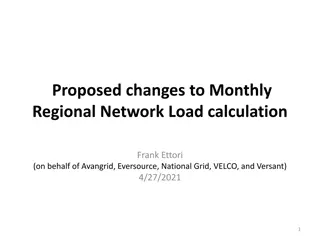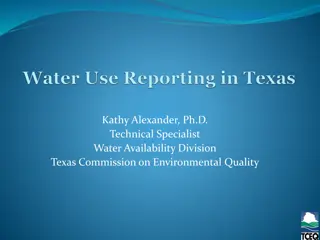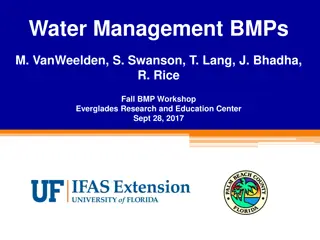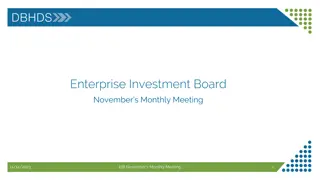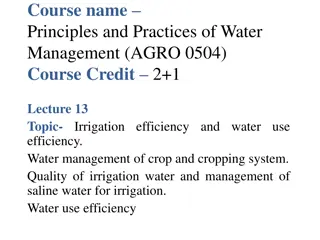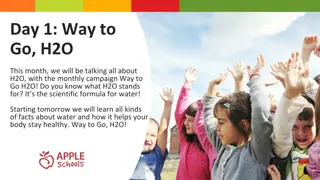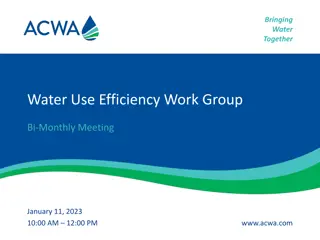Water Use Efficiency Work Group Bi-Monthly Meeting Agenda
The Water Use Efficiency Work Group Bi-Monthly Meeting Agenda for October 12, 2022, includes updates on drought response, legislative changes impacting water conservation, and strategies for water supply enhancement. Discussions cover indoor water use objectives, turf replacement programs, water loss reduction, and variances in water regulations. The group also focuses on ACWA working groups and future steps in water management.
Uploaded on Sep 10, 2024 | 4 Views
Download Presentation

Please find below an Image/Link to download the presentation.
The content on the website is provided AS IS for your information and personal use only. It may not be sold, licensed, or shared on other websites without obtaining consent from the author. Download presentation by click this link. If you encounter any issues during the download, it is possible that the publisher has removed the file from their server.
E N D
Presentation Transcript
Bringing Water Together Water Use Efficiency Work Group Bi-Monthly Meeting October 12, 2022 10:00 AM 12:00 PM www.acwa.com
Meeting Agenda October 12, 2022 10:00 AM 12:00 PM A. Chair Welcome Elizabeth Lovsted B. Drought Update Chelsea Haines C. Legislative Updates Julia Hall i. Indoor WUE Objective ii. Turf Replacement Rebate Tax Exemption D. Water Use Objective Updates i. Water Loss Amy Talbot ii. DWR Recommendation: Outdoor Standard Fiona Sanchez iii. DWR Recommendations: CII Performance Measures Elizabeth Lovsted iv. Variances Elizabeth Lovsted E. ACWA Working Groups & Next Steps Chelsea Haines F. CA-NV AWWA Amy Talbot
Drought Update: States Response Chelsea Haines CA Water Supply Strategy Aug 2022 o Goal 1: Develop New Water Supplies o Goal 2: Expand Water Storage Capacity Above and Below Ground by 4 MAF o Goal 3: Reduce Demand o Goal 4: Improve Forecasting, Data, and Management, Including Water Rights Modernization 3.1 Build upon conservation achievements over the last two decades to reduce annual water demand in towns and cities by at least 500,000 maf by 2030. o SWRCB to develop short-term efficiency-based conservation targets for every urban retail water suppliers based on their unique characteristics like climate zone, water demand, residential landscape area, and population. The Board will compare water suppliers actual use to their estimated efficient use target and assign them a percent reduction, with a higher target for suppliers whose actual use is further from their efficient use target. o The State Water Board will advance adoption of new long-term water use efficiency standards, per existing statute (2018). o Once DWR provides its formal recommendations, the State Water Board will begin the process for enacting the regulation to ensure the rule will be in effect by January 1, 2024.
Legislative Updates Julia Hall AB 2142 (Gabriel, D-Encino) Income Taxes: Exclusion: Turf Replacement Water Conservation Program o Taxable years 2022 through 2026 o Gross income does not include any amount received a rebate, voucher or other financial incentive issued by a public water system, local government or state agency for participation in a turf replacement water conservation program o Legislative text
Legislative Updates Julia Hall SB 1157 (Hertzberg, D-Van Nuys) Urban Water Use Objectives: Indoor Residential Water o 2025 standard = 47 gpcd; 2030 standard = 42 gpcd o DWR, in coordination with the SWRCB, to conduct necessary studies and investigation to assess and quantify the economic benefits and impacts of the 2030 indoor standard on water, wastewater and recycled water systems and shall include saturation end-use studies DWR to summarize findings of studies and investigation to Legislature by Oct. 1, 2028 Based on studies and investigations, DWR may recommend an extended timeline for the 2030 standard or potential variances specific to the indoor standard, including: stranded assets, impacts on DACs, impacts to environmental flows, adverse impacts to wastewater or recycled water operations o Legislative Text Here o Signing Message Here
WUE Objective Update: Schedule & Status Elizabeth Lovsted Components Recs/ Draft Available Final Approved Indoor Residential WUE Standard Yes 11/30/21 Yes 9/28/22 Water Loss Standard Yes 9/2/22 *10/18/22 Outdoor Residential WUE Standard (ORWUS) Yes 9/29/22 WUE Standards for CII Outdoor Irrigation of Landscape Area with Dedicated Irrigation meters Yes 9/29/22 Variances for Unique Uses of Water No CII Water Use Performance Measures Yes 9/29/22 Guidelines and Methodologies for Calculating Urban Water Use Objectives No UWMP and WSCP Guidelines Yes Yes 3/21
WUE Objective Update: DWR Recommended Outdoor Standards Fiona Sanchez Irrigated Area and Water Source Residential Dedicated Irrigation Meter (DIM) Irrigated (II) potable 2023-2030: 0.8 2030 on: 0.63 2023-2030: 0.8 2030 on: 0.63 Irrigable, not currently Irrigated (INI) May be adjusted based on future studies 20% of INI 2023-2030: 0.8 2030 On: 0.63 No INI component Special Landscape Areas Sports fields, functional turf Irrigated with Recycled Water 2023-2030: 0.8 2030 On: 0.63 1.0 New Construction and Rehabilitated Landscapes (post Jan 1, 2020) 0.55 0.45 Landscape Area Measurement Provided by DWR May be adjusted with water supplier data Suppliers to identify and complete measurements within 5 years after adoption
Fiona Sanchez WUE Objective Update: Outdoor Standards o Additional SLAs for CII Dedicated Irrigation Meters Bioengineered slopes Public swimming pools Supplemental water for ponds or lakes, including sustaining wildlife, recreation or other public benefits o Exempt Landscapes: exempt landscapes in Gov. Code 65598 and 2015 MWELO Cemeteries Registered historical sites Ecological restoration projects that do not require permanent irrigation Botanical gardens and arboretums open to the public o Effective Precipitation Would reduce outdoor budget by up to 25% Not addressed in recommendations to State Board, but previously incorporated into DWR s proposed calculation formula
Elizabeth Lovsted WUE Objective Update: Variances Recommendations on Variances for Unique Water Uses o The details containing the threshold of significance used will be provided in the full recommendation reports. o Sufficient evidence supports the establishment of the eight variances identified in the 2018 Legislation 2 should be refined: dust control limited to horse corals; irrigate vegetation for fire protection modified and expanded to during major emergencies o Add variance for significant use of water for home use medical devices consider further
WUE Objective Update: CII Performance Measures Ariel Flores Recommendations on CII Water Use Performance Measures o CII Water Use Classification System 19 categories of water uses Complete classifications within 5 years from SWRCB adoption DWR to provide technical assistance and develop guidance for CII mapping o CII Conversion Threshold 1 acre of landscape area irrigated by a mixed-use meter on a per parcel basis Complete landscape area measurement and determine if a dedicated meter (or equivalent technology) or in-lieu technologies will be implemented within 5 years from SWRCB adoption o In-Lieu Technologies Includes: (1) Water budget-based rate structures, (2) Water budget-based management without a rate structure, (3) Hardware improvements with enhanced performance, (4) Remote sensing combined with other data and hardware improvements, (5) Landscape plant palette transformation programs, (6) Others as approved by the State Water Board Complete landscape in-lieu technologies within 5 years after the first year of landscape measurement under the conversion threshold PM
WUE Objective Update: CII Performance Measures (cont.) Ariel Flores Recommendations on CII Water Use Performance Measures o CII Best Management Practices, Performance Measure, and Threshold for Implementation Selection of specific CII water user BMPs is subject to local determination Design CII-BMP implementation program specific to service area that includes: Threshold of significant are 1) CII water use sector that comprise the top 20 percent of all CII water use, and 2) individual top 2.5 percent of CII water users, excluding process water At least 1 CII from 5 recommended categories (outreach, technical assistance and education, incentives, landscape, collaboration and coordination, operational) Supported with documentation demonstrating increased water use efficiency Complete program development within 3 years after SWRCB adoption
WUE Objective Update: Bonus & Guidelines Elizabeth Lovsted Recommendations for Bonus Incentive, Methods of Calculation, and Supporting Data Requirements o Option 2a with some modification Last-In-First-Out inclusive of Water Loss Criteria Methodology Uses delivered amounts of potable recycled water to qualified end uses that implicitly include consideration of system losses Deferred under SWRCB adopts criteria and regulations for DPR permitting requirements Recommendations on Guidelines and Methodologies for Calculating UWUO o The comprehensive guidelines and methodologies are contained in the full recommendation report Compliance with 2020 SB X7-7 Target o Must maintain water use below SB x7-7 targets
Amy Talbot WUE Objective Update: Water loss Recent Comment Periods o February 2022 Primary o September 2022 Secondary Regulation/Economic Model o Coalition Comment Letters to discuss concerns some still remain o Changes Achieved: 1. Ongoing adjustments beyond 2023 to recognize and incentivize data quality improvements. 2. A compliance pathway for real water loss if a supplier s water loss standard is lower than the supplier s average baseline real loss by 30% or more. 3. Guidance and process for submitting supplier-specific input data for the economic model. 4. Supplier templates for apparent loss inventory and leak registry submissions. 5. Clarified terms, including ICF, apparent and real loss, and leakage definitions. 6. Time extension consideration for newly consolidated systems. 7. Flexibility for meter testing requirements for suppliers considering the offramp option. 8. Exemption for some small systems (remaining related concerns described above). 9. Leak registry reporting required every three years instead of annually (remaining related concerns described above). 13
Amy Talbot WUE Objective Update: Water loss Next Steps o Presented for approval at the October 19th SWB Board meeting (noon)Posted agenda, item detail and draft resolution for approval SWB Water Loss Webpage: https://www.waterboards.ca.gov/water_issues/programs/conservation_portal/wat er_loss_control.html o Updated regulation text to be posted soon o No substantive changes from the September 2nd draft o Stakeholder comments at Board meeting o Expect adoption next week PLEASE CHECK YOUR WATER LOSS TARGET/STANDARD 14
Chelsea Haines ACWA Next Steps ACWA Current WUE Working Groups WUE Overarching Chair: Elizabeth Lovsted Water Loss Working Group Chair: Amy Talbot Indoor WUE Working Group Chair: Amy McNulty Outdoor Working Group Chair: Fiona Sanchez CII BMPs Working Group Chair: Ariel Flores Looking to 2023 Variances Bonuses Guidelines and Methodologies ACWA Conference Program: Thursday, Dec. 1 @ 2:15 15
Amy Talbot WUE Objective Update: CA-NV AWWA AWWA released the Governmental Policies for Drinking Water Utility Water Loss Control Survey Results of Water Loss Control Policies Resource In 2021, AWWA s Technical and Educational Council again funded a survey of North American government agencies (state, provincial, and regional) to document o Policies that agencies are implementing in their jurisdictions and how they are measuring success, mostly regarding water audit methods and results, and o Information that agencies can use to better assess the water loss control needs of utilities within their jurisdiction and develop, implement, and evaluate effectiveness of policies intended to help meet these needs. Document link here: https://www.awwa.org/Portals/0/AWWA/ETS/Resources/Technical%20Reports/35392%20Gove rnmental%20Policies_FINAL.pdf?ver=2022-09-08-150806-283 16
Questions and Comments? Chelsea Haines, Regulatory Relations Manager Chelseah@acwa.com








